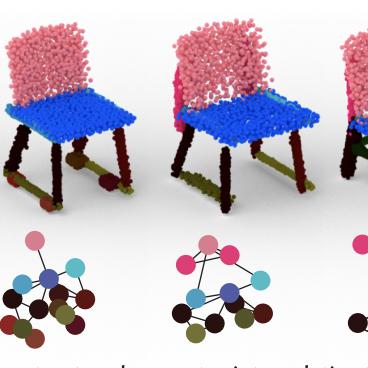Search Results for author: Faez Ahmed
Found 38 papers, 16 papers with code
DesignQA: A Multimodal Benchmark for Evaluating Large Language Models' Understanding of Engineering Documentation
1 code implementation • 11 Apr 2024 • Anna C. Doris, Daniele Grandi, Ryan Tomich, Md Ferdous Alam, Hyunmin Cheong, Faez Ahmed
This research introduces DesignQA, a novel benchmark aimed at evaluating the proficiency of multimodal large language models (MLLMs) in comprehending and applying engineering requirements in technical documentation.
Cooling-Guide Diffusion Model for Battery Cell Arrangement
no code implementations • 14 Mar 2024 • Nicholas Sung, Liu Zheng, Pingfeng Wang, Faez Ahmed
Our study introduces a Generative AI method that employs a cooling-guided diffusion model to optimize the layout of battery cells, a crucial step for enhancing the cooling performance and efficiency of battery thermal management systems.
DrivAerNet: A Parametric Car Dataset for Data-Driven Aerodynamic Design and Graph-Based Drag Prediction
1 code implementation • 12 Mar 2024 • Mohamed Elrefaie, Angela Dai, Faez Ahmed
This study introduces DrivAerNet, a large-scale high-fidelity CFD dataset of 3D industry-standard car shapes, and RegDGCNN, a dynamic graph convolutional neural network model, both aimed at aerodynamic car design through machine learning.
From Cloud to Edge: Rethinking Generative AI for Low-Resource Design Challenges
no code implementations • 20 Feb 2024 • Sai Krishna Revanth Vuruma, Ashley Margetts, Jianhai Su, Faez Ahmed, Biplav Srivastava
Generative Artificial Intelligence (AI) has shown tremendous prospects in all aspects of technology, including design.
NITO: Neural Implicit Fields for Resolution-free Topology Optimization
no code implementations • 7 Feb 2024 • Amin Heyrani Nobari, Giorgio Giannone, Lyle Regenwetter, Faez Ahmed
We introduce Neural Implicit Topology Optimization (NITO), a novel approach to accelerate topology optimization problems using deep learning.
BIKED++: A Multimodal Dataset of 1.4 Million Bicycle Image and Parametric CAD Designs
1 code implementation • 7 Feb 2024 • Lyle Regenwetter, Yazan Abu Obaideh, Amin Heyrani Nobari, Faez Ahmed
The dataset is created through the use of a rendering engine which harnesses the BikeCAD software to generate vector graphics from parametric designs.
From Concept to Manufacturing: Evaluating Vision-Language Models for Engineering Design
no code implementations • 21 Nov 2023 • Cyril Picard, Kristen M. Edwards, Anna C. Doris, Brandon Man, Giorgio Giannone, Md Ferdous Alam, Faez Ahmed
Large language models have demonstrated impressive capabilities in enabling this shift.
ShipGen: A Diffusion Model for Parametric Ship Hull Generation with Multiple Objectives and Constraints
no code implementations • 9 Nov 2023 • Noah J. Bagazinski, Faez Ahmed
The use of a DDPM to generate parametric ship hulls can reduce design time by generating high-performing hull designs for future analysis.
Conformal Predictions Enhanced Expert-guided Meshing with Graph Neural Networks
1 code implementation • 14 Aug 2023 • Amin Heyrani Nobari, Justin Rey, Suhas Kodali, Matthew Jones, Faez Ahmed
We demonstrate that the addition of conformal predictions effectively enables the model to avoid under-refinement, hence failure, in CFD meshing even for weak and less accurate models.
Learning from Invalid Data: On Constraint Satisfaction in Generative Models
no code implementations • 27 Jun 2023 • Giorgio Giannone, Lyle Regenwetter, Akash Srivastava, Dan Gutfreund, Faez Ahmed
This is particularly problematic when the generated data must satisfy constraints, for example, to meet product specifications in engineering design or to adhere to the laws of physics in a natural scene.
Surrogate Modeling of Car Drag Coefficient with Depth and Normal Renderings
no code implementations • 26 May 2023 • Binyang Song, Chenyang Yuan, Frank Permenter, Nikos Arechiga, Faez Ahmed
Generative AI models have made significant progress in automating the creation of 3D shapes, which has the potential to transform car design.
Multi-modal Machine Learning for Vehicle Rating Predictions Using Image, Text, and Parametric Data
no code implementations • 24 May 2023 • Hanqi Su, Binyang Song, Faez Ahmed
Our study underscores the importance of the data-driven multi-modal learning approach for vehicle design, evaluation, and optimization.
Counterfactuals for Design: A Model-Agnostic Method For Design Recommendations
no code implementations • 18 May 2023 • Lyle Regenwetter, Yazan Abu Obaideh, Faez Ahmed
In this paper, the authors frame the counterfactual search problem as a design recommendation tool that can help identify modifications to a design, leading to better functional performance.
DATED: Guidelines for Creating Synthetic Datasets for Engineering Design Applications
1 code implementation • 15 May 2023 • Cyril Picard, Jürg Schiffmann, Faez Ahmed
Overall, this paper offers valuable insights for researchers intending to create and publish synthetic datasets for engineering design, thereby paving the way for more effective applications of AI advancements in the field.
Ship-D: Ship Hull Dataset for Design Optimization using Machine Learning
1 code implementation • 14 May 2023 • Noah J. Bagazinski, Faez Ahmed
However, the lack of publicly available ship design datasets currently limits the potential for leveraging machine learning in generalized ship design.
ADVISE: AI-accelerated Design of Evidence Synthesis for Global Development
no code implementations • 2 May 2023 • Kristen M. Edwards, Binyang Song, Jaron Porciello, Mark Engelbert, Carolyn Huang, Faez Ahmed
We explore the effectiveness of the human-AI hybrid team in accelerating the evidence synthesis process.
Diffusing the Optimal Topology: A Generative Optimization Approach
no code implementations • 17 Mar 2023 • Giorgio Giannone, Faez Ahmed
To address these issues, we propose a Generative Optimization method that integrates classic optimization like SIMP as a refining mechanism for the topology generated by a deep generative model.
Multi-modal Machine Learning in Engineering Design: A Review and Future Directions
no code implementations • 14 Feb 2023 • Binyang Song, Rui Zhou, Faez Ahmed
In the rapidly advancing field of multi-modal machine learning (MMML), the convergence of multiple data modalities has the potential to reshape various applications.
Beyond Statistical Similarity: Rethinking Metrics for Deep Generative Models in Engineering Design
no code implementations • 6 Feb 2023 • Lyle Regenwetter, Akash Srivastava, Dan Gutfreund, Faez Ahmed
This paper doubles as a review and a practical guide to evaluation metrics for deep generative models (DGMs) in engineering design.
LINKS: A dataset of a hundred million planar linkage mechanisms for data-driven kinematic design
1 code implementation • 30 Aug 2022 • Amin Heyrani Nobari, Akash Srivastava, Dan Gutfreund, Faez Ahmed
LINKS is made up of various components including 100 million mechanisms, the simulation data for each mechanism, normalized paths generated by each mechanism, a curated set of paths, the code used to generate the data and simulate mechanisms, and a live web demo for interactive design of linkage mechanisms.
Diffusion Models Beat GANs on Topology Optimization
1 code implementation • 20 Aug 2022 • François Mazé, Faez Ahmed
By introducing diffusion models to topology optimization, we show that conditional diffusion models have the ability to outperform GANs in engineering design synthesis applications too.
Towards Goal, Feasibility, and Diversity-Oriented Deep Generative Models in Design
no code implementations • 14 Jun 2022 • Lyle Regenwetter, Faez Ahmed
We benchmark performance of the proposed method against several Deep Generative Models over eight evaluation metrics that focus on feasibility, diversity, and satisfaction of design performance targets.
Design Target Achievement Index: A Differentiable Metric to Enhance Deep Generative Models in Multi-Objective Inverse Design
no code implementations • 6 May 2022 • Lyle Regenwetter, Faez Ahmed
Deep Generative Machine Learning Models have been growing in popularity across the design community thanks to their ability to learn and mimic complex data distributions.
FRAMED: An AutoML Approach for Structural Performance Prediction of Bicycle Frames
no code implementations • 25 Jan 2022 • Lyle Regenwetter, Colin Weaver, Faez Ahmed
Our work introduces a dataset for bicycle design practitioners, provides two benchmark problems for surrogate modeling researchers, and demonstrates the advantages of AutoML in machine learning tasks.
Deep Generative Models in Engineering Design: A Review
no code implementations • 21 Oct 2021 • Lyle Regenwetter, Amin Heyrani Nobari, Faez Ahmed
We present a review and analysis of Deep Generative Machine Learning models in engineering design.
PcDGAN: A Continuous Conditional Diverse Generative Adversarial Network For Inverse Design
1 code implementation • 7 Jun 2021 • Amin Heyrani Nobari, Wei Chen, Faez Ahmed
Engineering design tasks often require synthesizing new designs that meet desired performance requirements.
A Graph Neural Network Approach for Product Relationship Prediction
no code implementations • 12 May 2021 • Faez Ahmed, Yaxin Cui, Yan Fu, Wei Chen
By representing products as nodes and their relationships as edges of a graph, we show how an inductive graph neural network approach, named GraphSAGE, can efficiently learn continuous representations for nodes and edges.
Range-GAN: Range-Constrained Generative Adversarial Network for Conditioned Design Synthesis
1 code implementation • 10 Mar 2021 • Amin Heyrani Nobari, Wei Chen, Faez Ahmed
This work laid the foundation for data-driven inverse design problems where we consider range constraints and there are sparse regions in the condition space.
CreativeGAN: Editing Generative Adversarial Networks for Creative Design Synthesis
1 code implementation • 10 Mar 2021 • Amin Heyrani Nobari, Muhammad Fathy Rashad, Faez Ahmed
GAN models, however, are not capable of generating unique designs, a key to innovation and a major gap in AI-based design automation applications.
BIKED: A Dataset for Computational Bicycle Design with Machine Learning Benchmarks
1 code implementation • 10 Mar 2021 • Lyle Regenwetter, Brent Curry, Faez Ahmed
In this paper, we present "BIKED," a dataset comprised of 4500 individually designed bicycle models sourced from hundreds of designers.
MO-PaDGAN: Reparameterizing Engineering Designs for Augmented Multi-objective Optimization
1 code implementation • 15 Sep 2020 • Wei Chen, Faez Ahmed
Despite their success in capturing complex distributions, existing generative models face three challenges when used for design problems: 1) generated designs have limited design space coverage, 2) the generator ignores design performance, and 3)~the new parameterization is unable to represent designs beyond training data.
MO-PaDGAN: Generating Diverse Designs with Multivariate Performance Enhancement
no code implementations • 7 Jul 2020 • Wei Chen, Faez Ahmed
Deep generative models have proven useful for automatic design synthesis and design space exploration.
Deep Generative Modeling for Mechanistic-based Learning and Design of Metamaterial Systems
no code implementations • 27 Jun 2020 • Liwei Wang, Yu-Chin Chan, Faez Ahmed, Zhao Liu, Ping Zhu, Wei Chen
For microstructure design, the tuning of mechanical properties and complex manipulations of microstructures are easily achieved by simple vector operations in the latent space.
METASET: Exploring Shape and Property Spaces for Data-Driven Metamaterials Design
1 code implementation • 1 Jun 2020 • Yu-Chin Chan, Faez Ahmed, Li-Wei Wang, Wei Chen
In answer, we posit that a smaller yet diverse set of unit cells leads to scalable search and unbiased learning.
PaDGAN: A Generative Adversarial Network for Performance Augmented Diverse Designs
1 code implementation • 26 Feb 2020 • Wei Chen, Faez Ahmed
With this new loss function, we develop a variant of the Generative Adversarial Network, named "Performance Augmented Diverse Generative Adversarial Network" or PaDGAN, which can generate novel high-quality designs with good coverage of the design space.
Forming Diverse Teams from Sequentially Arriving People
no code implementations • 25 Feb 2020 • Faez Ahmed, John Dickerson, Mark Fuge
Our method has applications in collaborative work ranging from team formation, the assignment of workers to teams in crowdsourcing, and reviewer allocation to journal papers arriving sequentially.
An Algorithm for Multi-Attribute Diverse Matching
no code implementations • 7 Sep 2019 • Saba Ahmadi, Faez Ahmed, John P. Dickerson, Mark Fuge, Samir Khuller
Bipartite b-matching, where agents on one side of a market are matched to one or more agents or items on the other, is a classical model that is used in myriad application areas such as healthcare, advertising, education, and general resource allocation.
Diverse Weighted Bipartite b-Matching
1 code implementation • 23 Feb 2017 • Faez Ahmed, John P. Dickerson, Mark Fuge
Bipartite matching, where agents on one side of a market are matched to agents or items on the other, is a classical problem in computer science and economics, with widespread application in healthcare, education, advertising, and general resource allocation.








